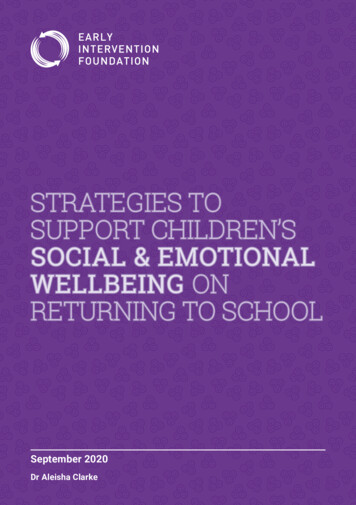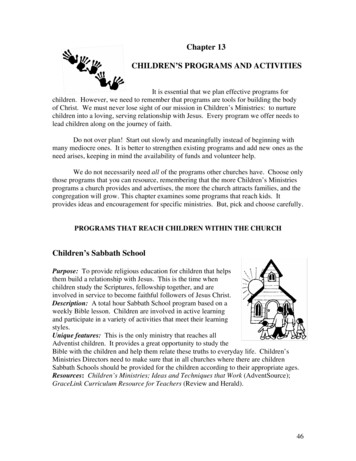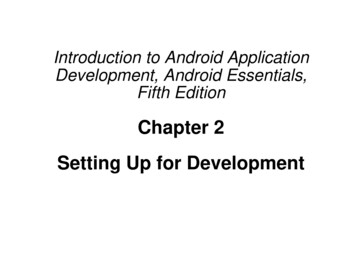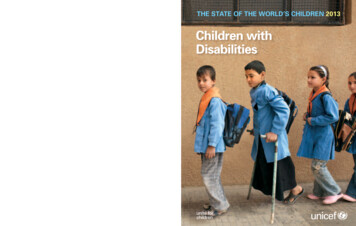
Transcription
STRATEGIES TOSUPPORT CHILDREN’SSOCIAL & EMOTIONALWELLBEING ONRETURNING TO SCHOOLSeptember 2020Dr Aleisha Clarke
ContentsIntroduction.3Emotional development.6Tips to support emotional development. 7Examples of activities & strategies. 8Relationship skills.14Tips to support relationship skills.15Examples of activities & strategies.16This booklet is available to download hool
IntroductionCoronavirus has disrupted significant aspects of children’s lives,threatening their sense of structure, predictability and security. Manychildren will return to school having experienced some level of stress,anxiety, or isolation. They may have contended with not seeing friendsor family, worries about catching the virus, a parent having lost a job,caring for a sick relative, or the loss of a loved one. Some children willhave been exposed to abuse, neglect or family violence.We know that children’s social and emotional needs are at theforefront of teachers’ minds as they prepare to welcome childrenback. A focus on emotional wellbeing and relationships will be criticalto children’s ability to re-engage and learn, and important for theirlonger-term outcomes.In 2019, we published guidance for primary schools on supportingchildren’s social and emotional skills. This guidance includes adviceon the simple activities, routines and strategies that teachers can useto support children to develop particular social and emotional skills.This short booklet provides you with a list of practical activities andstrategies that could be helpful as children return to school. Theseactivities and strategies are in line with Department for EducationRelationships Education Guidance (or Curriculum), which recommendsa focus on supporting children’s emotional wellbeing and relationshipbuilding through the delivery of high-quality, evidence-based teaching.Download the full guidance report at:www.EIF.org.uk/SEL-guidance3
EmotionaldevelopmentDuring this time, children may beexperiencing a range of emotions –they may feel worried, sad, lonely,or frightened for example. It can bedifficult for children to know what theyare feeling and why they are feelingthat way. This is a good time to focuson children’s emotional development,supporting them to recognise what theyare feeling, articulate it and managestrong emotions.4Strategies to support children’s social and emotional wellbeing on returning to school
Tips for supporting children’semotional development Encourage children to talk about their emotions.» For children who have difficulty talking about theiremotions, help them to label the feeling and encouragethem to talk about it: eg “It looks like you might befeeling worried, can you tell me why?”» The simple act of naming the emotion can help childrenunderstand it more clearly. There is no such thing as a bad emotion.» All emotions are normal and natural, though they can beexperienced as either comfortable or uncomfortable.Explain to children that it is normal to feel sad, worried,or angry, and that talking about our emotions can help.» A key message to relay is that it is perfectly okay to talkabout our feelings but it is not always okay to act on ourfeelings (i.e. control your behaviour not your feelings). Share your own feelings.» Don’t be afraid to share your own feelings with childrenduring the day, using a wide range of emotion words.Sharing your feelings helps children learn to identifytheir own emotions more accurately.5
Examples of activities & strategies tosupport children’s emotional developmentEmotional knowledgeThere are several ways of increasing children’s emotionalvocabulary.Feelings displayCreate a feelings display in the classroom: for example, a Feelings Tree,with the leaves being the feelings words, a Feelings Wheel or an EmojiBoard.Use the feelings display to explore how the children are feeling duringthe day. For example, children can place their name or photo on a relevantemotion within a feelings display to indicate how they are feeling whenthey arrive in the morning, or at the start of the afternoon.Feelings diaryOlder children might like to record how they are feeling over the courseof the week. By keeping a record of their emotions, children can betterunderstand and process how they are feeling. As part of this exercise,children can identify one thing that made them feel happy during the day.6Strategies to support children’s social and emotional wellbeing on returning to school
Emotional expressionEmotional expression enables children to tell others how theyare feeling.Using ‘I’ messagesA simple strategy is to encourage the use of ‘I’ messages to articulatehow you feel and why: eg “I feel X because ” Encourage children to use ‘I’ messages to describe how they arefeeling and why they are feeling this way: eg “I feel lonely because ” Provide supportive prompts to children who have difficulty talkingabout their emotions: eg “It looks like you might be feeling worried, isthat right?” Model ‘I’ messages yourself. It is useful for the children to hear theteacher using ‘I’ messages throughout the day to describe how theyfeel.7
Managing difficult emotions(emotional regulation)Strengthening their skills to manage difficult emotions suchas worry, anger, or sadness can help children to cope with thestresses brought about by Covid-19 in a more positive way.Self-calming & relaxation strategies8 Deep belly breathing: Sit in an upright position. Place your hands onyour belly and take a deep breath in through your nose for four counts.Then exhale through your mouth for four counts. Feel your belly riseand fall. Repeat for a few minutes. Bubble breathing: Imagine you are outside blowing bubbles, hold yourtub of bubbles, dip your bubble stick in, take a deep breath and blow asmany bubbles as you can. Play peaceful, relaxing music: Encourage children to focus on theirbreathing while they listen. Practise muscle relaxation: Sit in an upright position or lie on thefloor. Squeeze the muscles in the top of your legs, hold for threeseconds, and let them go limp. Repeat for different parts of the body:imagine you’re holding an orange and squeezing all the juice out withyour hands. Stretch your arms out in front of you as if you are tryingto catch something. Move your shoulders up to your ears. Pull in yourtummy muscles. Wrinkle up your face. Relax your whole body as ifyou’re a rag doll. Do some yoga: Research has shown that yoga can help to improvechildren’s emotional regulation, mood and resilience. There are a rangeof videos on YouTube that you can use to practise yoga with children.Strategies to support children’s social and emotional wellbeing on returning to school
Positive self-talkWhen children experience a strong emotion such as worry, often thereis an underlying thought (self-talk) accompanying this emotion whichintensifies how they are feeling. When self-talk is negative, children canbecome anxious more easily.Teach children to use positive self-talk (helpful thoughts) to calm theiremotions. Brainstorm positive self-talk statements that children can usewhen faced with difficult scenarios.Examples of positive self-talk (helpful thoughts) include: “I can calm down” “I can do this” “Take a deep breath.”Recognising body cuesHelp children to become aware of the early physiological signs of strongemotions, and encourage them to talk about how they are feeling: eg“I can see that you are all worried, can I help?”Examples of physiological signs include: heart beating sweaty palms knees or hands shaking tone of voice facial expression rapid breathing.If a child has difficulty expressing themselves, try to put into words whatthey might be feeling and why, and check with them if this is the case.9
Ways to feel betterCreate a ‘Ways to feel better’ poster for the classroom. Brainstorm withchildren things that they can do to help them feel better when they arefeeling worried, sad, or lonely for example. Children can represent theseideas pictorially and display their poster in the classroom.Refer to these strategies at different moments during the day if childrenhave difficulty managing how they are feeling.Examples of positive self-talk (helpful thoughts) include:10 take five deep breaths yoga exercises or stretches belly breathing read your favourite book listen to your favourite music write down or draw how you are feeling ask someone for help.Strategies to support children’s social and emotional wellbeing on returning to school
5 Day Mood Booster ChallengeA similar activity for older children is to create a 5 Day Mood BoosterChallenge: children brainstorm a range of simple, mood-boostingactivities that they would like to complete over the course of a week.These activities could be done at home or at school.Examples of activities include: write a card to someone make a cake take a day off from screens make a list of 10 things you like about yourself send someone a message of appreciation finish the sentence “The best thing in my life right now is ” ask someone at home “What can I do to help you?” and then do it perform a random act of kindness.11
RelationshipskillssskillLockdown measures have resulted inreduced opportunities for children toengage with their peers and other adultsoutside of the home. When children returnto school, a renewed focus on supportingthem to interact positive with their peersand to navigate social situations maybe needed.12Strategies to support children’s social and emotional wellbeing on returning to school
Tips for supporting children’srelationship skills Support good communication skills.» Set aside time during the day for talking and listening toeach other. Circle time is a useful activity for this. Model good communication skills.» Maintain eye contact with children. Give children achance to finish speaking before responding.» Tune in to children’s body language and what that mightbe telling you: eg “Michael, you’re very quiet today, iseverything ok?” Work together to solve the problem.» When discussing conflict / social problem situations,try to avoid solving the problem for the child. Insteaddiscuss with the children involved what they could dodifferently. Provide lots of praise.» This is important to remember any time you observechildren demonstrating good communication skills,relationship skills and problem-solving skills.13
Examples of activities & strategies tosupport children’s relationship skillsSpecific relationship skills you might like to work on in thecontext of Covid-19 and children returning to school includerelationship-building skills, good communication skills and useof problem-solving skills in relation to conflict situations.Relationship-building skills14 Class norms: Draft a class contract together with the children whichsets out what children would like their class to look like and feel likewhen they return. Encourage children to think about the behavioursand expectations that they feel are important, such as listening whenothers are speaking, taking turns, and respecting the opinions ofothers. Older children can work in small groups to draft their owncontract and share it with the class. Circle time: Circle time is a useful opportunity to discuss relationshipbuilding. Circle time games and ice-breakers can be used to developchildren’s friendship skills: for example, give a compliment to theperson sitting beside you. Teachable moments: You can use real-life classroom situations tosupport relationship building, for example, in supporting childrento think about what they are saying or doing to another child. Findopportunities where children demonstrate good relationship skillsand praise this behaviour, such as when they are sharing, when theyactively include someone in an activity, or when they listen to anotherchild’s point of view. Group work: This can be used to practise relationship skills in a newcontext. Assign children in pairs or small groups to a task, remindingthem about good communication and listening skills.Strategies to support children’s social and emotional wellbeing on returning to school
Communication skills Engage in some playful activities where the teacherdemonstrates poor communication skills, such as arms folded,interrupting someone who is speaking, shrugging shoulders, ornot looking at the other person. Encourage children to discusswhat you could do better to show that you are actively listeningor communicating clearly. Make a class poster of good communication and listening skills.Refer to the poster during class activities. Praise the use of goodcommunication and listening skills.Conflict resolution & problem solving skillsChildren may require support in addressing conflict or problem situationsthat arise with their peers. You can support children to solve problems andmake constructive choices.To do this, help children to: Identify the problem: Help children to articulate the problem anddescribe how it is making them feel. Brainstorm possible solutions: Support children in coming up with arange of solutions to the problem. It might be helpful to create somesolution cards that you can discuss – options could include, forexample, ‘Ask someone for help’, ‘Shout’, ‘Say sorry’, or ‘Walk away’. Identify the pros and cons of each solution. Pick a solution: Encourage children to pick a solution that is safe, fairand leads to comfortable feelings. Test it out: Encourage children to try out their solution and see whathappens. If it doesn’t work out, they can try another solution.15
The Early Intervention Foundation (EIF) is an independentcharity established in 2013 to champion and support theuse of effective early intervention to improve the lives ofchildren and young people at risk of experiencing pooroutcomes.EIF is a research charity, focused on promoting andenabling an evidence-based approach to early intervention. Our work focuses on the developmental issues thatcan arise during a child’s life, from birth to the age of 18,including their physical, cognitive, behavioural, and socialand emotional development.Early Intervention Foundation10 Salamanca Place, London SE1 7HBW: www.EIF.org.ukE: info@eif.org.ukT: @TheEIFoundationP: 44 (0)20 3542 2481First published in September 2020. 2020
children's social and emotional skills. This guidance includes advice on the simple activities, routines and strategies that teachers can use to support children to develop particular social and emotional skills. This short booklet provides you with a list of practical activities and strategies that could be helpful as children return to school.










